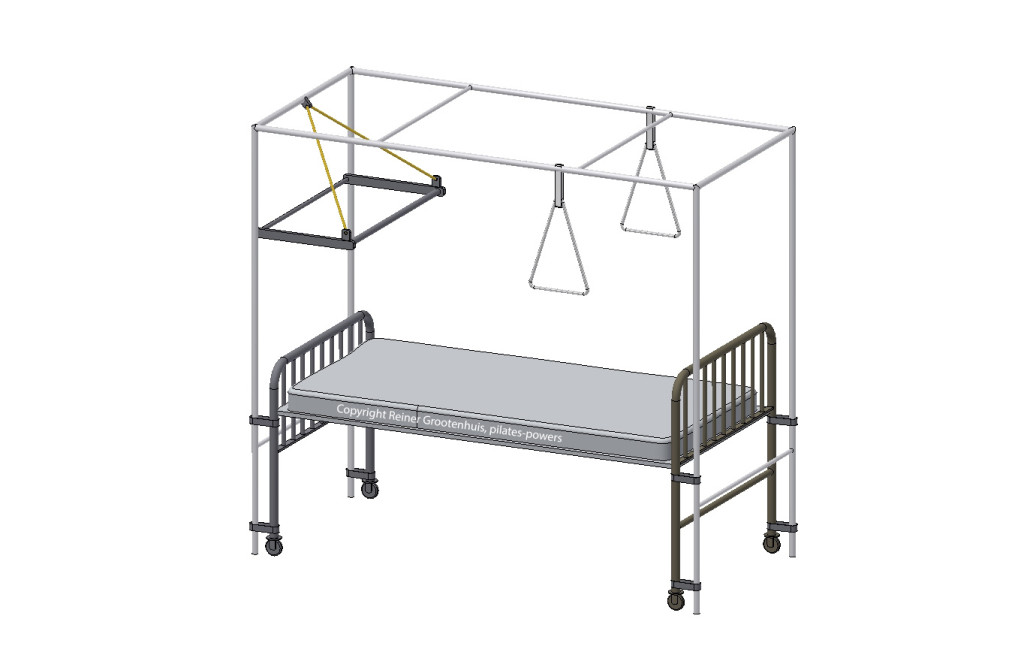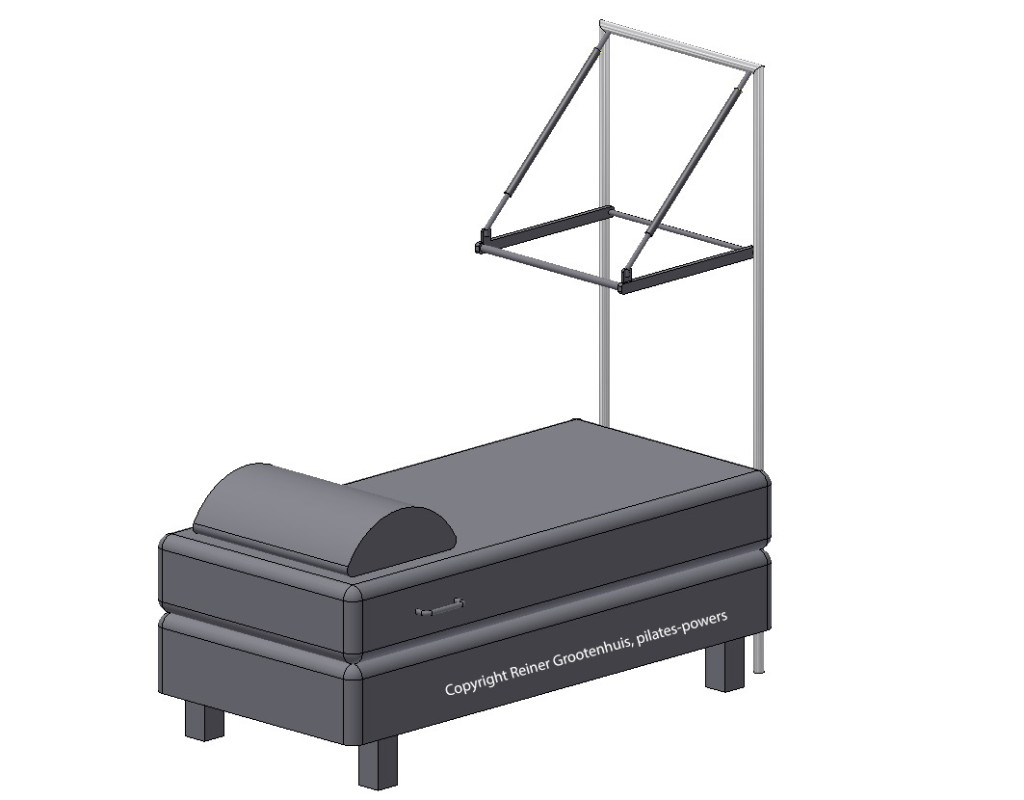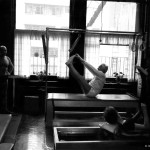Joe Pilates on the Cadillac – thank you IC Rapoport
May 29, 2019
The History of the Cadillac
by Reiner Grootenhuis
Be sure to check out Reiner’s brand new Cadillac manual, available at Amazon, at the VERY FAIR price of $67
The Cadillac and I didn’t have an easy start. Training on the Cadillac, I was regularly experiencing feelings from “pleasantly pulled apart and set free” to “folded together”. When I opened my Pilates studio, I was torn – should I purchase Reformers or Wall Units, the little brother of the Cadillac, for the group classes? In the end, I chose the Wall Units because I could also do and combine mat exercises with them.
When I started teaching the Tower classes, I quickly realized that I still had a lot to learn to teach sensibly and fluently. On the Cadillac, in comparison to the Mat and the Reformer, there are no exercise sequences that were optimized by Joseph Pilates or others, as some kind of starting point that one could use. I attended conferences and training courses, studied every new video on Pilatesology and Pilates Anytime, and experimented with variations myself. With every lesson, I learned and still learn.
Today, after years of almost daily work with the Tower and Cadillac, my repertoire of exercises and knowledge of the exercises’ factors for success have widened enormously. On the one hand, this awakened my desire to pass on the variety of exercises – both traditional and more modern versions. On the other hand, I also added a few exercise variations, of which I am sure that other Pilates teachers have come up with similar ones. So, I started to create a Cadillac training manual for the Pilates education I offer in my studio. As part of so that it can be studied more closely.creating this Cadillac manual (with part 1 now being published in English and German), I needed to research the history of the Cadillac.
What I learned is that in addition to the main room, Joseph Pilates’ studio had a room reserved for private clients with special problems. There, precursors of the Cadillac, such as the “Massage Table” or “Rehabilitation Table”, can be seen on old archive recordings of Joseph Pilates. Basically, it was a massage table at the end of which a metal frame was attached. This metal frame was above head height when looked at from the ground; arm and leg springs, as well as the Roll-Down-Bar, could be attached there at different heights. Besides the “Table” – or “Table with Trapeze” as it was also called – there was also a Reformer in this special room.
According to Romana Kryzanowska, the name ‘Cadillac’ was given to the “table” by a customer of Joseph Pilates in the 1940s. It should be noted that the Cadillac, a General Motors car brand, was the luxury brand par excellence in the first half of the 20th century. Just as comfortable and special as a real Cadillac, the higher mat and sitting level of Joseph Pilates’ Cadillac was also suitable for older people who had problems sitting on a low mat. Furthermore, it was easier for the trainer to support the customer during the exercises.
At some point, it seems that the Cadillac was not only reserved for Joseph Pilates’ private clients. For example, in pictures taken during a photo shoot in 1951 for LIFE magazine (showing opera singer Roberta Peters working out in Joseph Pilates’ studio), you could also see a Cadillac in the main training room. Right beside it was the “Guillotine”, also called “Gym in a Doorway”.
The Guillotine and the Cadillac share some similarities, so it is exciting to see both so close together. Both offer resistance for overhead training, which can be used as orientation and against which you can align yourself. Both devices further offer many attachment possibilities for different springs. Joseph Pilates also developed a smaller version of the guillotine that is unknown today and can only be spotted on the contact prints of I.C. Rapoport.
The Cadillac – Hospital Bed Hybrid
In addition to the already mentioned predecessors, there also were designs that looked like a converted hospital bed. On the basis of archive photographs, I commissioned an illustrator to create a 3D model of the Cadillac – Hospital Bed hybrid for the Cadillac manual, so that it can be studied more closely.

The cross bars running at the top were used to attach the Trapeze Bar with springs and Trapeze Strap for the feet, but also to hold a Trapeze Bar with the Trapeze Strap, which almost reached down to the bed and in which you could hang your head softly. This principle seems to still be appealing nowadays, as Dr. Steve Sudell Jr. started a very successful Kickstarter project called “The Neck Hammock”.
The Push-Through-Bar springs from above were fixed in a central position, contrary to today’s standard. The springs from below were attached on the outside. As you can see from the technical drawing, it was relatively easy to dock the Cadillac extension to the ordinarily mobile hospital bed and turn it into a training device. Unfortunately, we know very little about the reason for which Joseph Pilates built this device. Did he want to demonstrate that hospital beds could be converted into Cadillacs?
Or are the persistent rumors about his imprisonment in the Knockaloe Internment Camp on the Isle of Man (September 1915 to March 1919) true and Joseph Pilates worked with sick and wounded people in one of the five “hospitals” in the camp during this time, dating the design from back then? As Javier Pérez Pont & Esperanza Aparicio Romero repeatedly point out in their biography, Joseph Pilates himself neither claimed to have worked in one of the hospital wards himself nor are there any indications of this in the camp documents.
As a last possibility, this model was perhaps a predecessor of Joseph Pilates’ “Bednasium”, also called “V-Bed”. A bed, which had the V-shape favored by Joseph Pilates for sleeping at night and could be transformed into a flat surface through a lever in the morning. At the end of the bed, it had corresponding hangers for springs, just like the massage table, so that one could start training immediately after getting up in the morning.
In Chuck Rapoport’s photo, taken on October 4, 1961, in the original Pilates Studio in New York, Joseph Pilates demonstrates the Bednasium with the neck stretcher.
The Devana
A probably later development was “The Devana”, a device combining a mat with an integrated Small Barrel, a Reformer, and a Tower. Interestingly, the Reformer was hidden under the upper box. It was simply flipped back, and a Reformer appeared underneath. This combination, in another form and unfortunately without the Small Barrel, is still very popular nowadays. With modern versions, however, you do not fold the mat to the side, but usually have to add a larger plate. Joseph Pilates’ device, in this respect, was much more practical.

Carola Trier’s Cadillac
Another version of the Cadillac is the version built by Joseph Pilates for Carola Trier. Jillian Hessel, a student of Carola Trier, took over one of the old Cadillacs from Trier’s studio and Balanced Body renewed the lower frame, which, by the way, in its original condition, was the Bednasium.
There were a few special features, such as two additional crossbars at the open end of the Cadillac. One in the middle to also attach springs centrally, and one at foot height to stay stable against the bar. On the other hand, there were foot straps at the sides of the Cadillac, which were intended to fix the other leg to the Cadillac, e.g., for one-legged Leg Circles.
Wall Units and Springboards
Today, the combination of High-Mat and a Cadillac head-end as a so-called “Wall Unit” or “Tower” is particularly popular. Here, however, the hanging exercises of the Cadillac can no longer be performed, which is why some Pilates teachers say that these Wall Units are not even “half a Cadillac”. An opinion, which I honestly do not share.
A seemingly new and even more-reduced development is the so-called springboard, a wooden board with many eyelets at different heights in which the Roll-Down-Bar, arm and leg springs can be attached. Only ‘seemingly’ new, since Joseph Pilates himself designed a home-version of the guillotine he called ‘Tower’ or ‘A Gym in a Doorway’ – a pole that was fixed halfway up inside the door frame and could be used for Roll-Down-Bar and leg spring exercises. Something I described in the Pilates Intel Article titled Going Archival.
By the time when the photographer I.C. Rapoport visited the Joseph Pilates’ “gymnasium” in 1961 on behalf of Sports Illustrated, the Cadillac had been upgraded to a “window seat” and stood proudly at the end of the row of Reformers. I am pretty sure the Cadillac will retain this well-deserved “window seat” in Pilates training.
Be sure to check out Reiner’s brand new Cadillac manual, available at Amazon, at the VERY FAIR price of $67
Reiner Grootenhuis

Besides obtaining a diploma in psychology and an MBA, Reiner Grootenhuis has studied the healing and martial arts of the Southern Shaolin Monastery Weng Chun.
He completed the training as a Pilates instructor for Pilates mat and equipment at the Pilates educational academy Body Arts & Science International.
He is the founder and operator of the largest Pilates forum worldwide, pilates-contrology-forum on Facebook, which includes 9200 Pilates instructors. He also offers a free of charge hugly successful pilates-contrology-marketplace for selling and buying Pilates equipment on Facebook which has almost 8300 members.
At the beginning of 2012, he opened the pilates-powers studio only 25 km away from Joseph Pilates hometown.
2014 Kathy Corey appointed him a member of the Board of Directors of the Pilates Heritage Congress, which takes place every two years in the hometown of Joseph Pilates.
In 2015, he published the first publicly available German training manual on the Wunda Chair and 2016 an Baby/Arm Chair manual.
In 2017, Reiner completed the Kathy Corey Mentor program, in which he learned the methods and exercises of teachers trained directly by Joseph Pilates such as Kathy Grant, Ron Fletcher, Eve Gentry, Bruce King and Romana Kryzanowska.
2018 Reiner published the first publicly available German Pilates Cadillac manual.
Since November 2017 Reiner has been a Pilates Intel Expert for the online magazine Pilates Intel for which he writes regularly.
Since September 2018 Reiner has been nominated as a member of the Certification Committee of the German Pilates Association.


